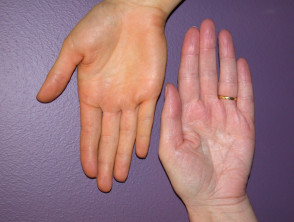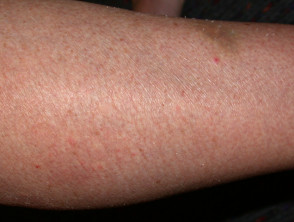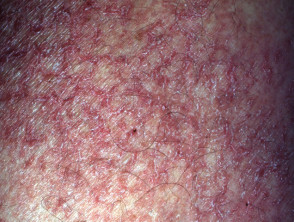Introduction
Abnormal levels of circulating thyroid hormone (thyroxine) and underlying diseases may lead to alterations in the appearance of skin, hair and nails. The thyroid gland can be overactive, resulting in hyperthyroidism, or underactive, resulting in hypothyroidism, discussed here.
What is hypothyroidism?
In contrast to hyperthyroidism, in hypothyroidism, the thyroid gland is underactive, causing a reduction in thyroxine production.
Who gets hypothyroidism?
Hypothyroidism can occur at any age and sex but is most commonly seen in females during menopausal years (age 40–50 years).
- Females are eight times more likely to be affected than males.
- Hypothyroidism is common in individuals with a personal or family history of an autoimmune disorder such as type 1 diabetes, pernicious anaemia, vitiligo, lichen sclerosus and Addison disease.
- Genetic conditions associated with hypothyroidism include Down syndrome, Turner syndrome and cystic fibrosis.
What causes hypothyroidism?
There are several causes for hypothyroidism.
Autoimmune thyroiditis
Autoimmune thyroiditis is also known as atrophic thyroiditis or Hashimoto disease when goitre is present.
- This is the most common cause of hypothyroidism in adults.
- Antibodies against the thyroid gland trigger inflammation and destroy the thyroxine-producing cells.
Subacute thyroiditis
Subacute thyroiditis is also known as De Quervain thyroiditis.
- Thyroiditis is inflammation of the thyroid gland.
- Subacute thyroiditis follows a viral infection or pregnancy.
- The gland is painful and tender for several months.
- Thyroiditis is usually self-limiting and resolves spontaneously without treatment.
- It initially causes temporary over-production of thyroid hormone (hyperthyroid phase), which is then followed by under-production (hypothyroid phase) before thyroid function returns to normal.
Iodine deficiency
The element iodine is crucial for thyroxine synthesis.
- Iodine deficiency is the most common cause of hypothyroidism worldwide, especially in areas where iodine is less available, including certain regions in South-East Asia and Africa.
Iatrogenic hypothyroidism
Hypothyroidism may arise from medications.
- Excessive intake of carbimazole or propylthiouracil used to treat hyperthyroidism.
- Radioactive iodine (used to treat hyperthyroidism)
- Amiodarone, an iodinated drug used in heart disease, which can induce both hyperthyroidism and hypothyroidism
- Lithium, often used for mental illness and eating disorders. It can also induce hyperthyroidism and hypothyroidism
- Interferon-alpha
- Interleukin-2
- Iodine-containing contrast media
- Thyroid surgery
Congenital hypothyroidism
Congenital hypothyroidism, or cretinism, may result from the absence or incomplete development of the thyroid gland, defects in thyroid hormone metabolism or hypothalamic-pituitary axis dysfunction. It is rare.
- Incidence is approximately 1 in 4,000 live births
- It is more commonly seen in multiple pregnancies (twins)
- There is a 2:1 female-to-male ratio
- It may due to a genetic defect
Rare causes of hypothyroidism
Rare causes of hypothyroidism include:
- Infiltration of the thyroid gland by granulomas in sarcoidosis, or amyloid in systemic amyloidosis.
- Pituitary gland disease, causing secondary hypothyroidism
- Hypothalamic gland disease, causing tertiary hypothyroidism
What are the clinical features of hypothyroidism?
Hypothyroidism results in a reduction in the body’s metabolic rate. It is characterised by:
- Cold peripheries with pale and dry coarse skin
- Eczema craquelé – a form of dermatitis in which there is a crazy paving splitting of the skin surface
- A yellowish hue to the skin secondary to carotenoderma
- Sparse and brittle hair, which comes out in handfuls
- Loss of hair in the outer third of eyebrows
- Slow growing, ridged and brittle nails
- Myxoedema, resulting in puffy face, eyelids, hands and feet; a presentation of mucinosis
- Delayed wound healing.
Other common systemic symptoms due to hypothyroidism include weight gain, cold intolerance, low mood and menstrual disturbances (irregular or heavy period).
Hypothyroidism
Clinical features of congenital hypothyroidism include:
- Hypotonia and lethargy
- Feeding difficulties, resulting in poor weight gain and failure to thrive
- Constipation
- Hoarse cry with reduced frequency of crying
- Puffy appearance; large head with swollen limbs and genitalia
- Large anterior fontanelle
- Cold and mottled skin especially on the extremities
- Flattened or broadened nose associated with nasal obstruction
- Macroglossia (enlarged tongue)
- Goitre
- Umbilical hernia
- Cardiac abnormalities: bradycardia, cardiomegaly or pericardial effusion
Congenital hypothyroidism
What are the complications of hypothyroidism?
Serious complications may occur if hypothyroidism left untreated:
- Cardiovascular heart disease, due to high levels of cholesterol and triglyceride
- Myxoedema coma (hypothyroid coma), characterised by hypothermia, reduced the level of consciousness and seizures. Myxoedema coma is a life-threatening medical emergency that requires urgent hospital treatment. The mortality rate is up to 50%, especially in the elderly.
How is hypothyroidism diagnosed?
Hypothyroidism is diagnosed with thyroid function tests (TFTs).
- Serum TSH is usually high.
- In pituitary or hypothalamic disease, TSH can be low or normal.
- Serum T4 and T3 levels are usually low.
- In subclinical hypothyroidism, TSH is mildly raised in the presence of normal T4 and T3.
- In sick euthyroid syndrome*, TSH, T4 and T3 are all low.
*Sick euthyroid syndrome commonly occurs in patients who suffer from severe non-thyroidal illness such as sepsis, burns and trauma. It is usually transient, and treatment may not be required, as thyroid function typically reverts to normal following disease recovery.
| - | TSH | Free T4 (thyroxine) | Free T3 (triiodothyronine) |
|---|---|---|---|
| (Primary) hyperthyroidism | Low | High | High |
| Secondary hyperthyroidism | High | High | High |
| Subclinical hyperthyroidism | Low | Normal | Normal |
| Primary hypothyroidism | High | Low | Low or normal |
| Secondary hypothyroidism | Low or normal | Low | Low or normal |
| Subclinical hypothyroidism | Borderline high | Normal | Normal |
| Sick euthyroid syndrome | Low | Low | Low |
Serum autoantibodies are present in 90–95% of autoimmune thyroiditis. They should include:
- Anti-thyroid peroxidase (TPO) antibodies
- Anti-thyroglobulin antibodies.
Full blood count and inflammatory markers, such as C-reactive protein, are routinely included to screen for anaemia (commonly associated with hyperthyroidism) and systemic infection causing thyroiditis. Creatine kinase is tested to check for myopathy, and lipids are evaluated as hypercholesterolaemia and hypertriglyceridaemia are common in hypothyroidism.
Imaging should include:
- Ultrasound of the thyroid gland – especially where hypothyroidism is associated with a goitre
What is the treatment for hypothyroidism?
Levothyroxine is the first line of treatment to replace the lack of thyroxine in the body.
- Dose ranges from 25–150 mcg daily.
- A lower dose is prescribed initially and then gradually adjusted according to response and TSH level.
- Regular blood tests are required to ensure patients receiving the right dose of treatment.
Although side effects are uncommon, symptoms of hyperthyroidism can occur when too much thyroxine is taken — this includes diarrhoea, irritability, sweating and palpitation.
What is the outcome for hypothyroidism?
The majority of patients respond well to levothyroxine, and they usually take this medication for life.


